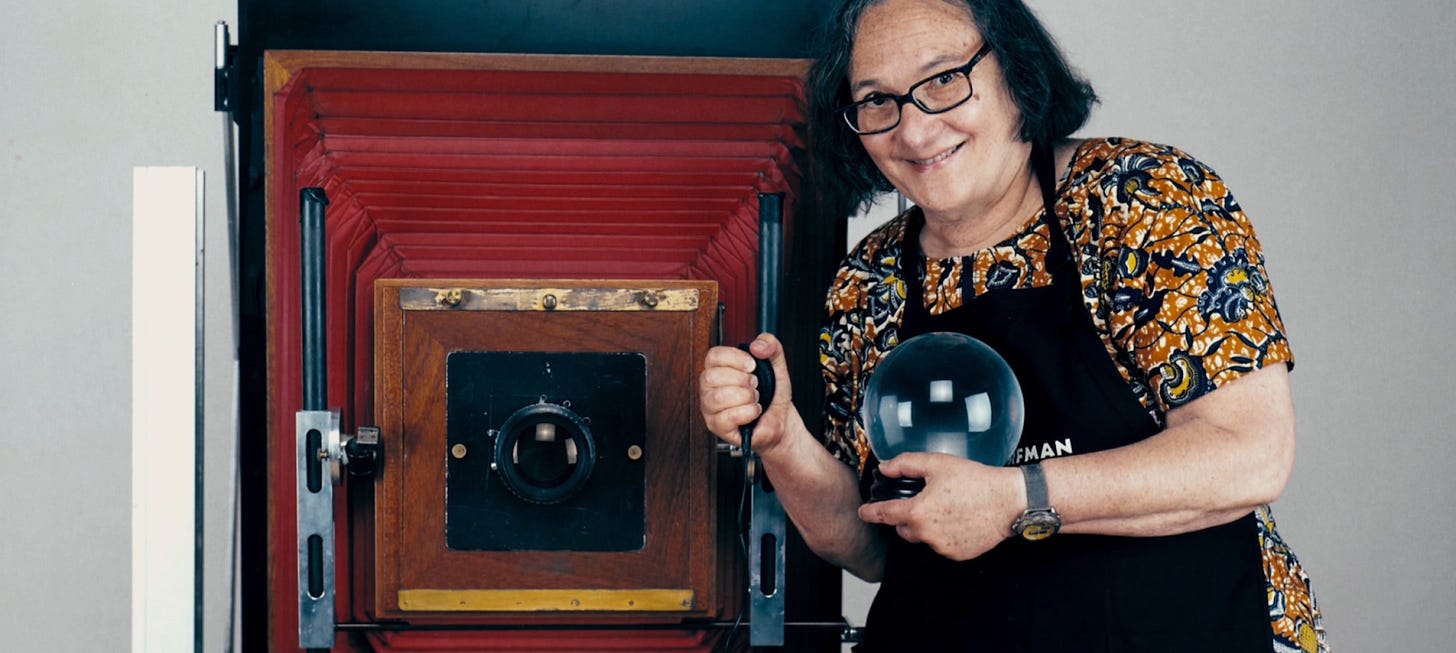The B-Side: Elsa Dorfman's Portrait Photography
Portraits within a portrait
There is a precision in Errol Morris’s films that makes one take nothing for granted; every second of footage and interview in the final edit matters, even if it seems trivial. The B-Side: Elsa Dorfman’s Portrait Photography introduces us to Elsa Dorfman, maybe the world’s most famous polaroid portraitist, looking at a portrait of her husband. She describes his outfit and its genesis; a suit coat with yellow high-viz tape sewn onto the front and back. The high-viz tape was her doing. She’s worried he’ll get hit by a car while riding his bike.
I saw The B-Side with a close friend when it opened at the Alamo Drafthouse in SF, and I didn’t remember much about it other than we both teared up multiple times and left the theatre talking about the “nature of art,” which was as ‘college-freshman’ as it sounds. I also remember it being invigorating and a lot of fun. The premise of this documentary is simple enough: Elsa Dorfman, the renowned photographer, goes through old photos and reminisces, with the occasional off-camera comment from Morris. She speaks of old friends and subjects, such as Allen Ginsberg and Joni Mitchell, and reflects on her early self-portrait work and photographs of her family.
Elsa Dorfman might be one of the most thoughtful yet unpretentious artists you’ll encounter. When asked by an interviewer on a television program in the 70s whether she thinks a “picture tells the truth?” she responds: “Absolutely not. You take twenty pictures in two minutes and they’re so different.” I think she may be wrong, however, to a degree. In another early scene, Elsa shows us a photo of her mother. She describes it emphatically as her favorite photograph of her mother. “I didn’t realize it at the time, but it is so, my mother. Bringing food, and my father being in the background but there.” She goes on; as the camera pulls out, we see her lost in the memory of her passed mother, detail after detail coming back to her from the photo. The film gives us a close-up of the warm smile on her mother’s face. We see the resemblance to Elsa, as she warmly smiles too. I could write about it at length, but it won’t do justice to the feelings the scene engenders. There is truth in this photograph. Before we get lost with Elsa, we’re on to the next picture…
We get a glimpse into Polaroid, the company, and their strikingly prescient vision of the future; the ability to capture any moment on film that you wish; instantly. We’re shown several of their historic models, but the real star of The B-Side, camera-wise, is the 20x24 camera. The 20x24 trotted onto the scene in 1976, offering large format portrait photography that utilizes the same technology we commonly refer to simply as ‘polaroids.” Elsa explains why the 20x24 camera is the closest thing we have to Ginsberg’s philosophy on writing but in film form. We learn the difference between 20x24 polaroid photography and traditional 35mm: In 35mm photography, the picture is a singular process, and the development of the film along with the printing is a separate process. 20x24 Polaroid photography creates a coupling of picture and process. Elsa runs her hand over an old portrait of Allen Ginsberg from 1982, admiring the detail of his brittle white and black beard. “There’ll never be film like this again. Ever. Ever.”
All of this is scored magnificently by Paul Leonard-Morgan, creating an emotional distortion field I enter willingly and happily. In conjunction with Dorfman's reminiscences, I let the swells and decrescendos manipulate me however they wish. As you may expect from a film with elderly statesman-like artists in conversation about the past, the conversation eventually turns to oblivion. “I’m amazed at how many of us aren’t still here.” Elsa says about the feelings she experiences when going through a box of old photographs and looking at the many loved ones who have departed. I was curious about what Elsa had gotten up to since this documentary came out, so I looked her up. Elsa Dorfman passed away in May of 2020.
Watching a documentary featuring artists talking about their art feels like a guilty pleasure. The B-Side feels particularly special because our subject, Elsa Dorfman, does so humbly but not self-deprecatingly. While watching, I realized I was watching a piece of art precisely like the photographs Elsa is presenting; A thing that captures (accurately, truthfully?) a moment in time. A memory in film form that will gradually dissipate over time, save for what feelings we can muster in memory or receive from secondary sources. What will you pull out of a drawer in ten or twenty years that causes you to stare out the window, letting nostalgia wash over you? Revisiting The B-Side wasn’t just a chance to become re-acquainted with a lovely little documentary. It was a chance to go back to sitting in a movie theatre in San Francisco in July of 2017, shedding a few tears with a friend, and briskly walking out of the theatre into the evening’s cold foggy air, excitedly debating what art is capable of, like kids in college.
The B-Side: Elsa Dorfman’s Portrait Photography
Directed by Errol Morris
2016
76 minutes
English
Stray Thoughts from the Editor
Hot Doc Summer is in full swing; last week, we watched The Janes and quit our jobs to protest the erosion of fundamental human rights in America. (We all quit our jobs, right guys? Guys?) This week the fare is lighter and more whimsical. A film that, if I’m lucky, I’ll get a chance to revisit throughout my life.
This obituary from the NY Times is a fitting and lovely tribute to Elsa Dorfman.
Do you have an all-time favorite documentary? Tell me about it!

